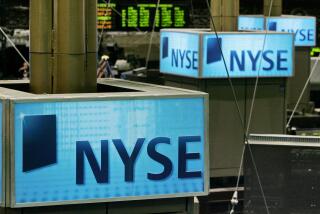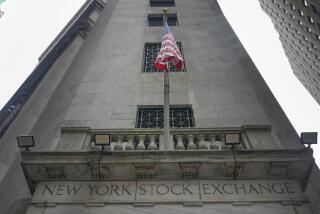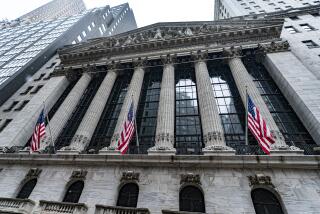Where markets stand as the new year begins
- Share via
Some snapshots of financial markets at the end of 2006:
* Within the blue-chip Standard & Poor’s 500 stock index this year, the top-performing sector among 10 broad industry groups was telecommunications, which surged 32.1%. Telecom got a lift from a wave of consolidation, including AT&T; Inc.’s purchase of BellSouth Corp.
The second-best sector was energy, up 22.2%. The worst performer: healthcare, up 5.8%, as shares of many large healthcare providers struggled amid rising competition.
* The annualized yield on the 10-year Treasury note, a benchmark for long-term rates, ended the year at 4.7%. That was up from 4.39% a year ago, but down from a peak of 5.25% in June.
Long-term rates fell in the second half of the year, helping to stoke the equity market, after the Federal Reserve stopped tightening credit and held its key short-term rate at 5.25%.
* The average price-to-earnings ratio of S&P; 500 stocks is about 16 based on S&P;’s estimate of the underlying companies’ operating earnings per share for 2006. The P/E ratio has fallen from 19 at the end of 2002 as earnings have risen faster than stock prices.
A P/E of 16 is about the average for blue-chip stocks since 1935, which means the market is in the middle range of its historical valuation -- neither extremely cheap, nor very pricey.
* Wall Street analysts almost universally expect corporate earnings growth to slow in 2007, even though they have generally underestimated growth for the last few years.
Standard & Poor’s analysts predict operating earnings for the S&P; 500 will rise 9.5% in 2007 compared with an estimated 14.9% advance this year.
Even if profit growth slows, any year-over-year percentage advance would mean that earnings would reach new highs.
* Stock market bulls think they have history on their side in 2007: It will be the third year of President George W. Bush’s second term. Historically, the market hasn’t fallen in the third year of a presidential term since 1939, according to Sam Stovall, investment strategist at S&P.;
The usual explanation for that trend is that the White House often pursues measures to bolster the economy, to improve the chances that the president’s party will retake the office in the following election year.
Also of historical note, Stovall said, is that the current bull market has entered its fifth year. Since 1942, there have been six bull markets that have made it to the five-year mark. The S&P; 500 advanced in two-thirds of those fifth years.
*
(BEGIN TEXT OF INFOBOX)
The Standard & Poor’s 500 index rose 13.6% in 2006, but the gains weren’t evenly distributed across industry sectors. Here’s how stocks fared, on average, within the index’s 10 major groups:
--
Telecommunications: + 32.1% | Energy: + 22.2% | Consumer discretionary*: +17.2% | Utilities: +16.9% | Financial services: +16.2% | Basic materials: +15.7% | Consumer staples**: +11.8% | Industrials: + 11.0% | Technology: + 7.7% | Healthcare: +5.8%
--
*Includes producers of big-ticket goods, media companies and restaurants.
** Includes producers of household products and packaged foods.
--
Source: Bloomberg News
More to Read
Inside the business of entertainment
The Wide Shot brings you news, analysis and insights on everything from streaming wars to production — and what it all means for the future.
You may occasionally receive promotional content from the Los Angeles Times.










